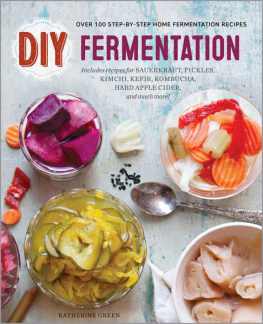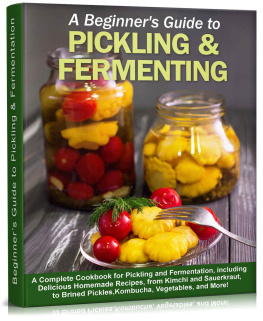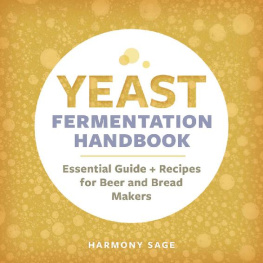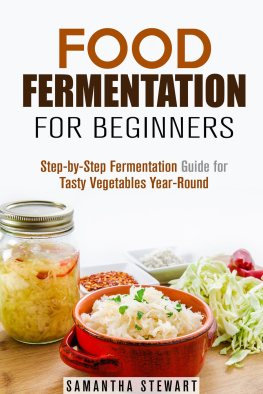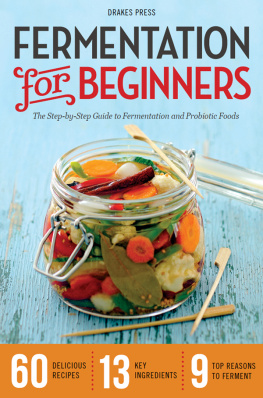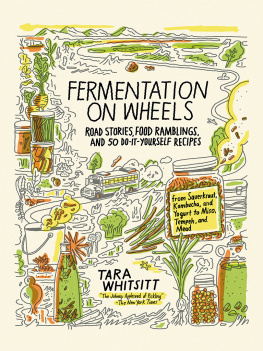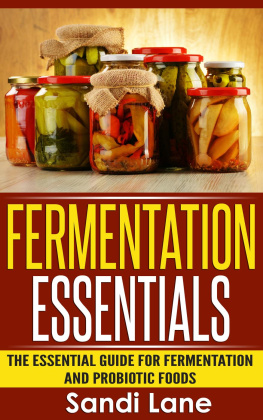DO-IT-YOURSELF FERMENTS

Is the art of fermentation new to you? Get started with these simple DIY ferments and unleash the crafty cook in you.
Sauerkraut () will be your trusty fermentation primer. Perfect for first-timers, a jar of homemade kraut will make even the simplest dinners sublime.
Kimchi () is a great next step for vegetable ferments. Prepare a batch and enjoy its probiotic benefits as an accompaniment to every meal.
Looking for a simple fruit ferment? Whip up a batch of Blackberry-Sage Jam () and jar it for a DIY gift that is sure to please.
Make your own Kombucha () and ditch the expensive store-bought bottles.
Happy Fermenting!
Copyright 2015 by Rockridge Press, Berkeley, California
No part of this publication may be reproduced, stored in a retrieval system or transmitted in any form or by any means, electronic, mechanical, photocopying, recording, scanning or otherwise, except as permitted under Section 107 or 108 of the 1976 United States Copyright Act, without the prior written permission of the publisher. Requests to the publisher for permission should be addressed to the Permissions Department, Rockridge Press, 918 Parker St., Suite A-12, Berkeley, CA 94710.
Limit of Liability/Disclaimer of Warranty: The publisher and the author make no representations or warranties with respect to the accuracy or completeness of the contents of this work and specifically disclaim all warranties, including without limitation warranties of fitness for a particular purpose. No warranty may be created or extended by sales or promotional materials. The advice and strategies contained herein may not be suitable for every situation. This work is sold with the understanding that the publisher is not engaged in rendering medical, legal or other professional advice or services. If professional assistance is required, the services of a competent professional person should be sought. Neither the publisher nor the author shall be liable for damages arising herefrom. The fact that an individual, organization or website is referred to in this work as a citation and/or potential source of further information does not mean that the author or the publisher endorses the information the individual, organization or website may provide or recommendations they/it may make. Further, readers should be aware that Internet websites listed in this work may have changed or disappeared between when this work was written and when it is read.
For general information on our other products and services or to obtain technical support, please contact our Customer Care Department within the United States at (866) 744-2665, or outside the United States at (510) 253-0500.
Rockridge Press publishes its books in a variety of electronic and print formats. Some content that appears in print may not be available in electronic books, and vice versa. TRADEMARKS: Rockridge Press and the Rockridge Press logo are trademarks or registered trademarks of Callisto Media Inc. and/or its affiliates, in the United States and other countries, and may not be used without written permission. All other trademarks are the property of their respective owners. Rockridge Press is not associated with any product or vendor mentioned in this book.
Interior photo credits: Shutterstock/Jack Jelly,
Cover photo credits: Penny de los Santos/Offset (front cover)
Illustrations 2015 by Tom Bingham
ISBN: Print 978-1-62315-528-5 | eBook 978-1-62315-585-8
CONTENTS
I
FUNDAMENTALS
CHAPTER 1
THE BASICS
CHAPTER 2
IN THE KITCHEN
II
RECIPES
CHAPTER 3
VEGETABLES
CHAPTER 4
FRUITS
CHAPTER 5
DAIRY
CHAPTER 6
GRAINS & BREADS
CHAPTER 7
LEGUMES
CHAPTER 8
MEAT & FISH
CHAPTER 9
VINEGARS & CONDIMENTS
CHAPTER 10
BREWS
CHAPTER 11
COOKING WITH FERMENTED FOODS
Appendix A:
The Dirty Dozen & the Clean Fifteen
Appendix B:
Measurement Conversions
INTRODUCTION
O nce upon a time, long before refrigeration allowed us the luxury of planning meals and storing food, fermentation was king. Originally used as a way to preserve foods, fermentation has given us some of the food worlds most treasured delights. Coffee, chocolate, cheese, beer, wine, and pickles all make use of this ancient process to transform food from its original state into something extraordinary.
Simply defined as a metabolic process that converts sugars into acid, gas, or alcohol, fermentation can take many forms. Although the standard American diet does not include a wide variety of these foods, many cultures around the world serve fermented food with just about every meal. These itemsoften raw and living foods teeming with beneficial bacteriacan improve health and vitality. Bonus: They taste great, too!
As early as the third century BC, laborers building the Great Wall of China were served fermented vegetables as part of their daily rations. From there, the tradition spread throughout Asia and Europe, with many far-ranging styles and varieties gaining recognition in different regions.
Fermentation was probably originally developed to help stretch the harvest and provide nourishment when fall changed to winter, but the end result is so much more than just preservation. The process of fermentation begins breaking down food, making the end product more easily digestible by the human body. This can provide relief to a system feeling the effects of modern processed foods, and can help balance the body to allow for healthy digestion and better absorption of nutrients.
Today in the United States, we are becoming aware of the health benefits of fermented foods. According to Tufts Universitys Gerald J. and Dorothy R. Friedman School of Nutrition Science and Food Policy, the fermentation process used to make sauerkraut and kimchi increases the glucosinolate in cabbagenaturally pungent compounds thought to fight cancer. Additionally, the healthy bacteria found in a number of fermented foods have been shown to increase immunity and decrease inflammation, autoimmune disorders, and allergies.
Supermarket shelves are lined with processed foods, such as breads, cheeses, vinegars, and condiments, all of which are laden with preservatives to keep them fresh. Additionally, many commercially packaged products undergo pasteurization to kill harmful bacteria, but this process also kills the healthy organisms your body needs. Although it may seem safer to eat these mass-produced products than items that you ferment in your own kitchen, thats just not true.

